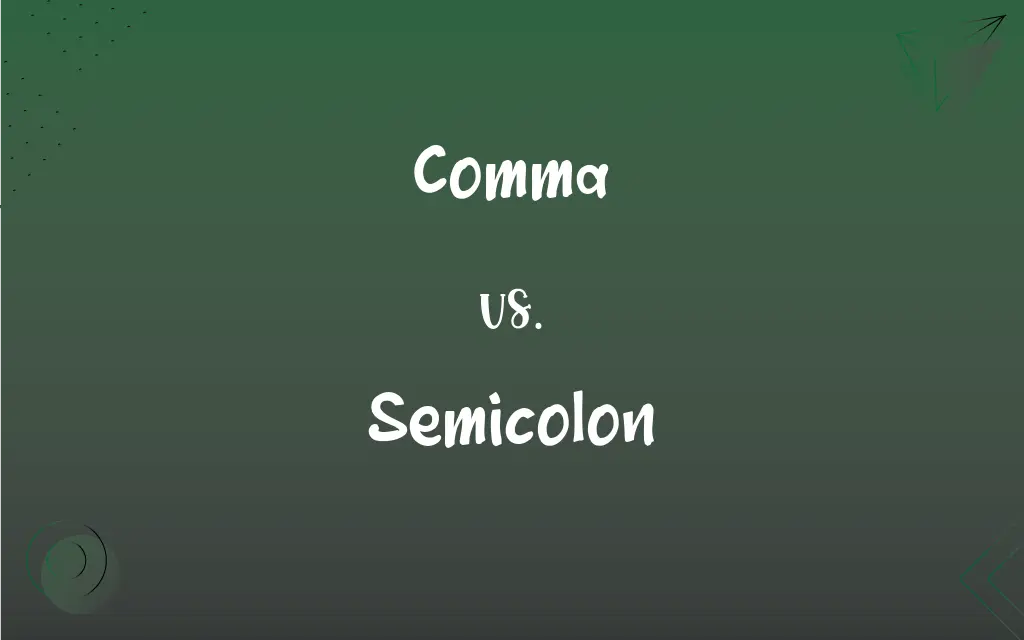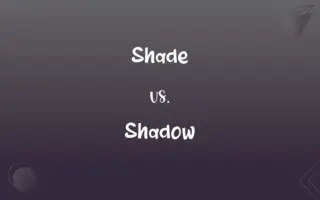Comma vs. Semicolon: What's the Difference?
Edited by Harlon Moss || By Janet White || Published on December 28, 2023
Comma is a punctuation mark used to indicate a pause or separation in a sentence. Semicolon is a punctuation mark used to link independent clauses or separate items in a complex list.

Key Differences
A comma is used to separate elements within a sentence, such as items in a list. A semicolon is used to connect closely related independent clauses without a conjunction.
Commas are often used after introductory elements or to set off clauses and phrases. Semicolons can separate items in a list where the items themselves contain commas.
Overuse of commas can lead to run-on sentences; they should not join independent clauses alone. Semicolons provide a stronger pause than a comma but less than a period, often clarifying complex sentences.
Commas are more common in everyday writing and are essential for clarity. Semicolons are less common and can be replaced by a period or conjunction in many cases.
A comma suggests a shorter pause than a semicolon, which provides a pause similar to a period but indicates a closer relationship between the clauses.
ADVERTISEMENT
Comparison Chart
Primary Use
Separating elements within a sentence, like in lists.
Linking independent clauses without conjunctions.
Secondary Use
Setting off clauses and phrases; after introductory elements.
Separating items in a list with internal commas.
Effect on Sentence Structure
Indicates a smaller pause; cannot join independent clauses alone.
Indicates a stronger pause; links closely related ideas.
Frequency in Writing
More common, used in various contexts.
Less common, often in formal or complex writing.
Alternative Punctuation
Can often be replaced by dashes or parentheses for emphasis or clarity.
Can be replaced by a period or conjunction to simplify sentences.
ADVERTISEMENT
Comma and Semicolon Definitions
Comma
A comma can separate independent and dependent clauses.
After the show, we went to a cafe.
Semicolon
A semicolon links two independent clauses without a conjunction.
I finished the project; I will present it tomorrow.
Comma
A comma indicates a short pause within a sentence.
We bought apples, oranges, and bananas.
Semicolon
Semicolons indicate a closer relationship between clauses than a period.
She loves to read; books are her escape.
Comma
Commas are used to separate items in a list.
She enjoys reading, writing, and traveling.
Semicolon
Semicolons are often used in formal or academic writing.
The experiment concluded; the results were inconclusive.
Comma
Commas set off nonessential clauses and phrases.
My brother, who lives in New York, is visiting.
Semicolon
Semicolons separate items in a list that contain commas.
We visited Paris, France; London, England; and Rome, Italy.
Comma
Commas are used after introductory words or phrases.
However, we decided to stay in.
Semicolon
A semicolon can clarify complex sentence structures.
The meeting was postponed; consequently, the deadline was extended.
Comma
(Grammar) A punctuation mark ( , ) used to indicate a separation of ideas or of elements within the structure of a sentence.
Semicolon
A mark of punctuation ( ; ) used to connect independent clauses and indicating a closer relationship between the clauses than a period does.
Comma
A pause or separation; a caesura.
Semicolon
The punctuation mark ;.
Semicolon
The punctuation mark [;] indicating a separation between parts or members of a sentence more distinct than that marked by a comma.
Semicolon
A punctuation mark (`;') used to connect independent clauses; indicates a closer relation than does a period
FAQs
When should I use a semicolon?
Use a semicolon to link closely related independent clauses or separate complex list items.
When should I use a comma?
Use a comma to separate list items, after introductory elements, or to set off nonessential information.
Can a semicolon join two sentences?
Yes, a semicolon can join two related independent sentences.
Is it okay to use many commas in a sentence?
Overuse of commas can make a sentence confusing; they should be used judiciously.
What is a comma?
A comma is a punctuation mark used for indicating a pause and separating sentence elements.
Is a semicolon stronger than a comma?
Yes, a semicolon provides a stronger pause than a comma.
Does a semicolon indicate a full stop?
No, it indicates a pause stronger than a comma but not a full stop like a period.
Can a comma replace a semicolon?
No, a comma and a semicolon have different functions and are not interchangeable.
Are commas used in compound sentences?
Yes, with a conjunction to link independent clauses.
What is a semicolon?
A semicolon is a punctuation mark used to link independent clauses or separate complex list items.
Can a comma join two sentences?
No, a comma alone cannot properly join two independent sentences.
Are semicolons used in complex sentences?
Semicolons can be used in complex sentences, especially to clarify relationships between clauses.
Can I start a sentence with a comma?
No, commas are not used to start sentences.
Do commas go inside or outside quotation marks?
In American English, commas usually go inside quotation marks.
Is a comma necessary after an introductory phrase?
Generally, yes, to separate the phrase from the main clause.
Can a sentence have both a comma and a semicolon?
Yes, in complex sentences where both punctuation marks are needed for clarity.
Can I use a semicolon in a list?
Yes, particularly in lists where the items themselves contain commas.
Should I use a comma before 'and' in a list?
This depends on style; in serial lists, a comma before 'and' (Oxford comma) is optional.
Can a semicolon be used to emphasize a point?
Yes, it can provide emphasis by clearly separating and linking related thoughts.
Should I use a semicolon before conjunctions like 'and' or 'but'?
No, a semicolon is not typically used before conjunctions.
About Author
Written by
Janet WhiteJanet White has been an esteemed writer and blogger for Difference Wiki. Holding a Master's degree in Science and Medical Journalism from the prestigious Boston University, she has consistently demonstrated her expertise and passion for her field. When she's not immersed in her work, Janet relishes her time exercising, delving into a good book, and cherishing moments with friends and family.
Edited by
Harlon MossHarlon is a seasoned quality moderator and accomplished content writer for Difference Wiki. An alumnus of the prestigious University of California, he earned his degree in Computer Science. Leveraging his academic background, Harlon brings a meticulous and informed perspective to his work, ensuring content accuracy and excellence.






































































